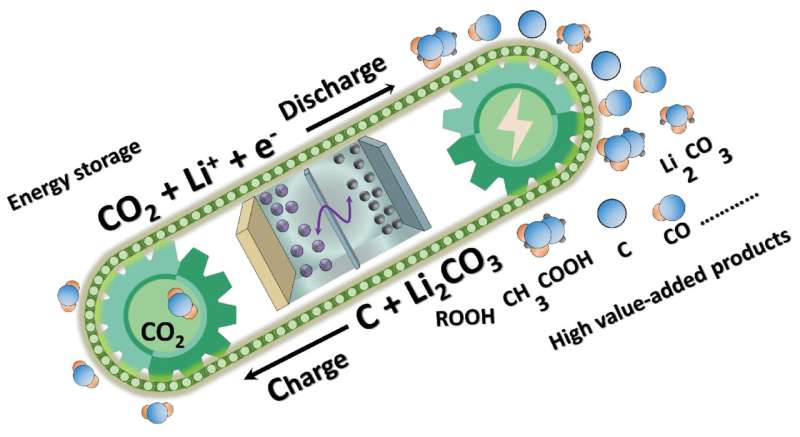Studying the challenges and prospects of lithium-carbon dioxide batteries

The lithium-carbon dioxide battery is an emerging energy storage and conversion device. Although development of these batteries is still in its infancy, scientists need a thorough understanding of the critical problems that must be overcome for these batteries to achieve their potential as new energy storage devices. An interdisciplinary research team has undertaken the study of lithium-CO2 batteries to better understand the challenges and prospects of these devices.
The team, led by researchers from The University of Adelaide, Australia, published their work on Mar. 21 in the journal Nano Research Energy.
Because carbon dioxide plays a key role in global temperature cycles, researchers have turned their attention to carbon capture and storage. Lithium-CO2 batteries offer an intriguing option, not only for the transformation of waste carbon dioxide to value-added products, but also for the storage of electricity from renewable power resources.
Compared with other metal-CO2 batteries, such as sodium-CO2 and zinc-CO2 batteries, lithium-CO2 batteries are much more promising not only in delivering the highest operating voltage and energy density, but also for potential use in the aviation and aerospace industries where lightweight materials are highly desirable. While the lithium-CO2 batteries hold great promise, they also face tremendous hurdles because of the carbon dioxide.
The team brought together specialists from various fields to tackle the issues with an interdisciplinary viewpoint. They set out to explore the problems faced by critical components in the battery, including the electrode, the interface, and the electrolyte. The team also suggested strategies for addressing these problematic issues. Their goal is to establish a context for further research on reversible and rechargeable alkali metal-based carbon dioxide battery systems.
“Specifically, we have figured out that the basic understanding of the electrochemical mechanism is still controversial, the performance at a high rate is still far from satisfactory for practical application due to the lack of efficient electrocatalysts,” said Zaiping Guo, a professor in the School of Chemical Engineering and Advanced Materials, The University of Adelaide. Their findings can help other researchers and stakeholders to better understand these batteries and to place their research in a feasible context.
“Despite the challenges, we have to say that, with continuous efforts, practical Li-CO2 batteries with highly efficient CO2 fixation and high energy storage are achievable,” Guo said. The team’s hope is that their review of the challenges and prospects for lithium-carbon dioxide batteries will inspire innovative ideas about batteries and catalysis, and provide the guidelines needed for researchers to develop other important energy storage devices involving metal and gas.
Looking ahead to future studies, the team will be exploring ideas for an efficient catalyst. “The main concern for a lithium-carbon dioxide battery lies in the slow kinetics of the electrode reactions, so the next step in the development of lithium-carbon dioxide is to seek an efficient catalyst that can boost the electrode reactions during battery charge and discharge,” Guo said.
Thinking beyond applications for the batteries here on Earth, the team sees long-range potential in more extreme environments. Using CO2 as a cathode material allows the energy system to offer unique advantages in aerospace exploration, such as on Mars where there is a CO2 concentration of up to 96 percent in the atmosphere.
“There is no doubt that there is a long way to go, and more investigation and a better fundamental understanding of high energy density Li-CO2 batteries require multidisciplinary and cross-field research, ranging from chemical engineering to material science, electrochemistry, and nanotechnology,” Guo said.
In addition to researchers from The University of Adelaide’s School of Chemical Engineering and Advanced Materials, the team also includes researchers from the University of Wollongong’s Institute for Superconducting & Electronic Materials.
Sulphur chemical technology improves battery lifespans
Zaiping Guo et al, Challenges and Prospects of Lithium−CO2 Batteries, Nano Research Energy (2022). DOI: 10.26599/NRE.2022.9120001
Provided by
Tsinghua University Press
Citation:
Studying the challenges and prospects of lithium-carbon dioxide batteries (2022, April 8)
retrieved 8 April 2022
from https://techxplore.com/news/2022-04-prospects-lithium-carbon-dioxide-batteries.html
This document is subject to copyright. Apart from any fair dealing for the purpose of private study or research, no
part may be reproduced without the written permission. The content is provided for information purposes only.
For all the latest Technology News Click Here
For the latest news and updates, follow us on Google News.
